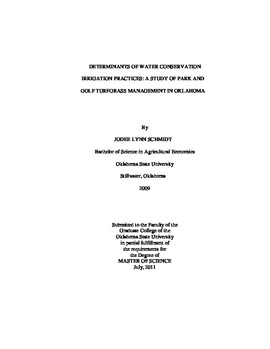| dc.contributor.advisor | Boyer, Tracy | |
| dc.contributor.author | Schmidt, JoDee Lynn | |
| dc.date.accessioned | 2014-04-15T19:52:55Z | |
| dc.date.available | 2014-04-15T19:52:55Z | |
| dc.date.issued | 2011-07-01 | |
| dc.identifier.uri | https://hdl.handle.net/11244/8722 | |
| dc.description.abstract | With urban and suburban sprawl increasing throughout Oklahoma, areas of previously non-irrigated pasture and/or croplands are being converted to homeowner and commercial landscapes generally composed of turfgrass. Continued increase in irrigated landscapes across the state will result in increased residential water demand making it important to determine current landscape irrigation practices and identify determinants of current irrigation practices used by Oklahoma turfgrass managers of athletic, golf, and park land. A survey of 148 Oklahoma professional turfgrass managers solicited information on facility characteristics and management and also the characteristics of the managers. The logit procedure was utilized for the regression analysis of the data to predict the likelihood of adoption of conservation practices, given the facility and individual manager's characteristics. Because adoption exceeded 50% of respondents for only three types of water conservation strategies, there appears to be a lack of motivation or incentive on the part of Oklahoma turfgrass managers to participate in water conservation. Even though respondents consider lowering facility watering costs to be an important motivation for adopting water conservation strategies, concern for maintaining performance and appearance of turfgrass for users overshadows those concerns as the most cited barrier to adoption. Conditions of non-adoption are not random, facilities with automated sprinklers are more likely to have invested in them to ensure turf aesthetics, city water connections indicate likelihood of higher returns to use from urban location and clientele and/or turf managers have already switched to private wells to avoid higher costs of treated water. Turfgrass facilities relying on municipal connections are in proximity to large populations therefore they strive to uphold landscape appeal with green, lush turf. Sod farm employees are more likely to be aware of how much water turfgrass varieties require allowing the maximization of profits by producing healthy grasses at the least cost. | |
| dc.format | application/pdf | |
| dc.language | en_US | |
| dc.publisher | Oklahoma State University | |
| dc.rights | Copyright is held by the author who has granted the Oklahoma State University Library the non-exclusive right to share this material in its institutional repository. Contact Digital Library Services at lib-dls@okstate.edu or 405-744-9161 for the permission policy on the use, reproduction or distribution of this material. | |
| dc.title | Determinants of Water Conservation Irrigation Practices: a Study of Park and Golf Turfgrass Management in Oklahoma | |
| dc.type | text | |
| dc.contributor.committeeMember | Chung, Chanjin | |
| dc.contributor.committeeMember | Moss, Justin | |
| dc.contributor.committeeMember | Sanders, Larry | |
| osu.filename | Schmidt_okstate_0664M_11639.pdf | |
| osu.college | Agricultural Sciences and Natural Resources | |
| osu.accesstype | Open Access | |
| dc.description.department | Department of Agricultural Economics | |
| dc.type.genre | Thesis | |
| dc.subject.keywords | logistic model | |
| dc.subject.keywords | recreation | |
| dc.subject.keywords | turfgrass | |
| dc.subject.keywords | water conservation adoption | |
